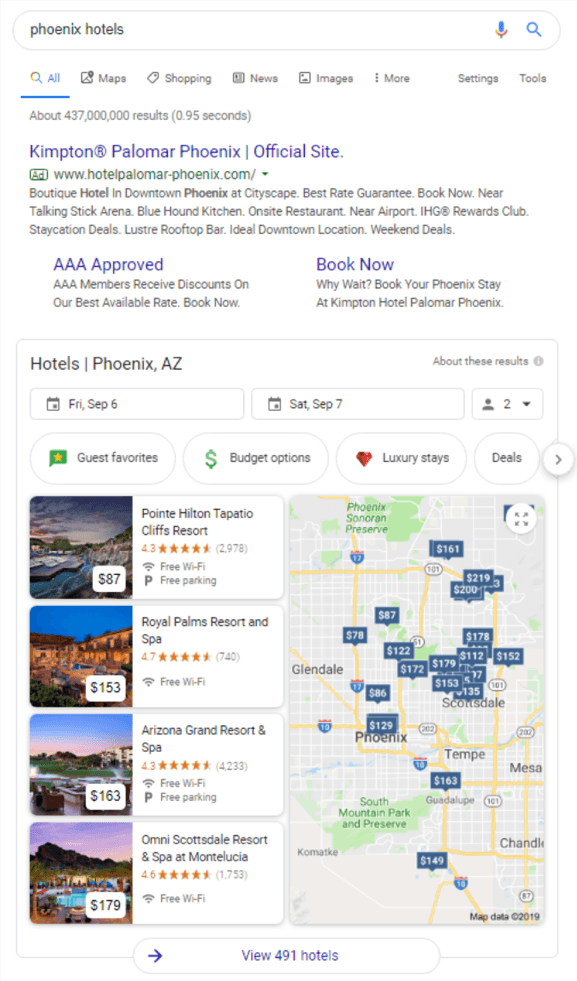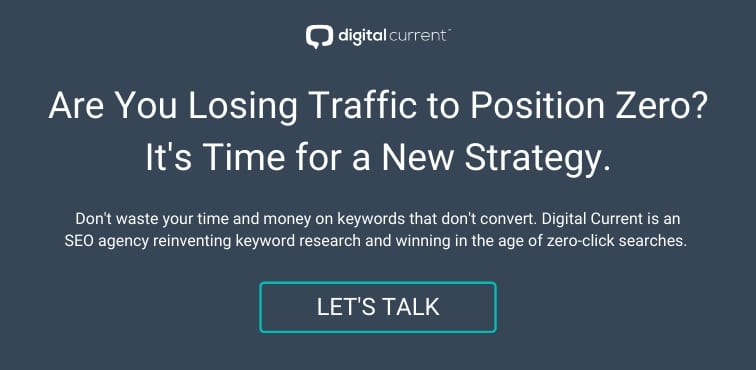That’s right. You’re not just competing with your “traditional” competition, but also Google itself.
That because now when a user enters a query in the Google search bar, the answer served in position zero, often called the featured snippet, frequently provides them with enough information that they end their search, without clicking on a web link to enter another site.
In other words, click-throughs aren’t happening because the user got what they needed and moved on.

That fact that Google added position zero isn’t surprising — they’re always making updates to better serve users. But what is surprising is how much it has impacted click throughs.
This came to light thanks to an article posted on Search Engine Land, which notes that “zero-click searches hit an all-time high in June.” The author, George Nguyen, actually quotes SparkToro founder Rand Fishkin and his Google clickstream research.
The article is a good read, as it delves into some implications of this discovery. But here’s the TL;DR:
- Zero-click searches have been on the rise for a few years now, finally reaching about 50% in June 2019 — and this isn’t a trend that’s stopping anytime soon (in September 2019 it hit 56%)
- Mobile searches, which drive the most search traffic these days, are also the largest culprit of zero-clicks (no surprise here)
- Pretty much every search happens on Google — 94% to be exact
- Paid search ads will probably start to see a decline in CTR (click-through rate) soon, too
And most importantly:
- There’s still marketing opportunity with zero-click searches — it just requires us to think a bit differently and double-down on rich, valuable content and long-tail keywords
Still, we as SEO marketers couldn’t help but be surprised.
Position Zero Threw the SEO Industry a Curveball
When Google announced and launched the position zero/featured snippet result, we were all under the impression that aiming for and successfully gaining that coveted position would lead to a deluge of click-throughs.
We were wrong.
In reality, we didn’t understand Google’s full purpose in rolling out this search experience update. Since people got the answer they needed right away, they had no reason to click on our website and head into our funnel. It also affected click-through rates in positions one, two, three … everything beneath position zero, too.
And we all know traffic drives revenue (well, it’s a little more complicated than that, but that’s a story for another time), so if we aren’t grabbing traffic through our position zero win, we’re not getting the leads we need to serve our clients’ and our own business objectives.
And there’s another layer of mystery to all this: voice search.
Voice search (primarily done on mobile) drives this zero-click trend because Google’s fond of reading out loud the zero-position result, be it a featured snippet or a Knowledge Panel.
But therein lies some immediate opportunity: brand awareness, because Google is reading your featured snippet aloud and crediting your website as the source.
The same opportunity is found in non-voice searches, because the user reads the answer and (hopefully) takes note of which website offered it.
Trouble is, awareness is hard to measure and even harder to attribute to revenue online.
Should you be worried?
The Types of Websites in Most Danger
Well, if your website focuses on things like recipes, simple instructions or other easily digestible content often presented in full or in almost-full by the position-zero feature, then, yeah, you’re in trouble. Traffic is probably going to drop.
In fact, anyone who relies primarily on traffic to drive revenue — say, those who rely on advertising spend — is probably, rightfully, quite worried.
Another industry facing the crunch from this search experience shift is hospitality, specifically hotels. When a user can book (and compare) hotel stays in the Knowledge Panel (which populates position-zero on desktop) without leaving Google’s search results page, they’re typically not going to click through to the hotel’s website. That means all the wonderful marketing copy and beautiful imagery on that website is for naught. The opportunity to communicate a brand, a property’s allure and even basic amenities falls off.

But you don’t have to take this lying down.
How to Earn Clicks in a Position-Zero World: Know Your Audience
No, in fact, you still have plenty of opportunity to garner clicks and pull users into your website ecosystem. It’s all about targeting the keywords and producing rich, valuable content that can’t be fully appreciated with a position-zero search result. Something that goes beyond a simplistic answer, offering deeper meaning and a bigger payoff for the user.
It’s all about understanding the buyer’s journey. Search intent. Basically, where is your user in their journey to purchase and how can you meet their needs and lead them into the next phase?
There are a few ways to go about this.
Winning the Featured Snippet
First could be tackling the featured snippet itself. This result will still be the highest performer in terms of click-through rate. You can increase your chances of pulling a user in by providing a clear, succinct answer right away, but offering a more in-depth analysis in the following paragraph. This could address variations of the question, caveats to consider, best options for addressing the question or otherwise giving them a more “meaty” answer. This encourages them to consider clicking through for more clarity, further perspective or additional answers. Once you have their trust in the featured snippet itself, you can show them you have even more to offer if they just … click!
Presenting a Better Path
If you’re not in the featured snippet (as most won’t be), you need a slightly different angle. If the position-zero result presents an answer to the question, then you need to immediately propose the value of clicking through on your subsequent result. If a user does even scroll beyond the featured snippet, then they probably want more than that featured answer — maybe the snippet didn’t actually answer their question (Google’s not perfect, after all), or they want proof or further elaboration or to know what to do with that answer.
So the featured snippet didn’t satisfy the user. They then might click on a subsequent result. This could be a ranking of the best options that considers the user’s need for the “now what?” Or it could be an interesting (and we use that word with plenty of weight) perspective or an additional angle of consideration: “You know xx, but have you considered yy?”
The goal in all of this is walking that user into the next step, thinking past the question to a subsequent, logical, engaging continuation. You’re showing them value they didn’t receive in the featured snippet or that they may not have even realized they wanted. But after reading the answer in the featured snippet, then seeing your take on the matter (whether they scrolled because they wanted more or because they saw you as the second or third result), they’re eager to read more — on your site.
Re-Evaluate Your Query Targets
What else can you do? Look to a different search query. If a search can be answered in a simple position-zero blurb, then maybe that’s not the sort of user you should be engaging. If they’re satisfied with a featured snippet answer, are they really valuable? Are they really interested in the type of product or service you offer? Perhaps not.
Consider expanding on the search query with modifiers (best, cheapest, etc.) or with longer-tail versions that get more specific (“how does a featured snippet affect news websites?”; “how do I rank for a featured snippet?”).
Again — the key here is considering the buyer’s journey. Move SEO and content marketing away from the top of the funnel, which may be overflowing with position-zero leads of varying qualification, and into a narrower section in which buyers are more focused. If you can answer those questions, you’re going to grab attention from users that may actually convert. Often, you can find quick wins with this strategy of answering lower-volume, lower-difficulty search queries.
Remember that Google is still the keeper here and it typically knows best. If you’re trying to rank for a keyword and it seems impossible, maybe you’re not accurately matching your users’ intents. Consider, for instance, trying to rank on a national scale for a keyword for which Google serves up local results. Maybe you’re a “lawn care” company gunning for that number-one spot, but Google knows most people searching for this keyword want local results. Therefore, you’ll never beat out Johnny Q’s Local Lawn Care (and its Knowledge Panel position-zero result) unless you’re also promoting a local office or branch offering those services. In many cases, simple keyword ranking isn’t a good measure of SEO success.
In this case, you would want to instead focus on more individual, local optimization efforts (zeroing in on cities or regions). You would also want to adjust your goals for national rankings to align more with thought-leader content, aiming for higher-level queries that go beyond “lawn care” — maybe “is aeration necessary for good lawn care” or “when should I hire professionals for lawn care.”
Go Ahead, Shoot for the Moon — Er, Featured Snippet
All in all, snagging that position-zero result or getting as high up the SERP as possible is still a primary goal in driving traffic. The largest slice of the pie — even if that pie is shrinking — is still the best scenario.
And you’ll need SEO optimization to get there. That means:
- Detailed on-page SEO optimization
- Page structures, organizations and layouts that consider featured snippets
- Schema codes that tell Google exactly what it’s looking at
- User experience in tip-top shape (since Google is valuing UX more and more)
So yes, this news that more than half of all Google searches end without a click is alarming — but it’s far from devastating. As with any realization and research regarding Google’s inner workings, the more we know the better. In the end, it all comes down to putting resources towards tried-and-true tactics that build authority in the long term. Make sure your website is up to date on the latest technical, local and on-page SEO. Make sure you’re creating valuable, informative, authoritative content. And make sure you know your customer, what they’re searching for and their stage in the buyer’s journey.
Get an Expert Team on Your Side
The best way to stay ahead of Google’s future updates and have a fighting chance at ranking for a position-zero search result is to choose an SEO agency that understands the importance of knowing your audience and how they relate to your business objectives. An agency that leads with detailed, persona- and buyer’s journey-centered keyword research.
If you’re looking to find more conversions through search or regain that coveted spot you’ve since lost ground on, let’s talk about how our SEO experts can help.



